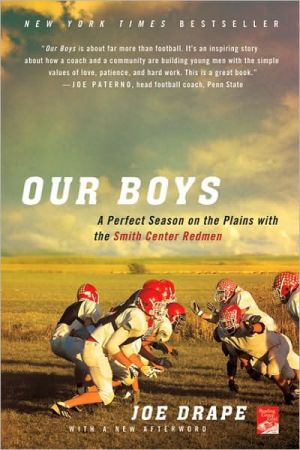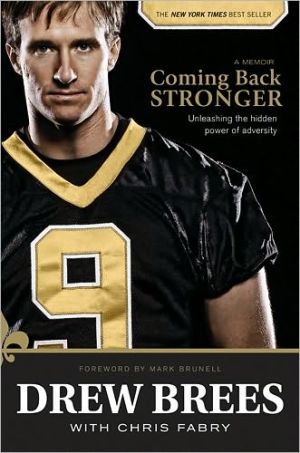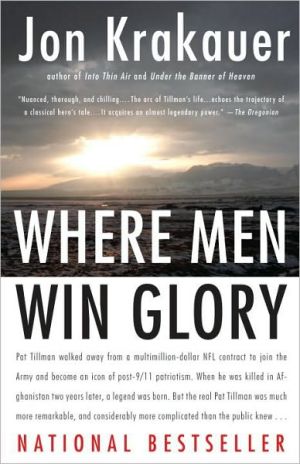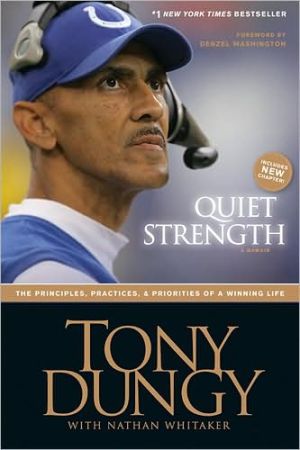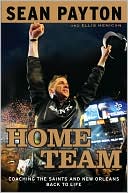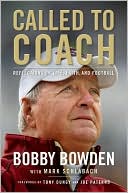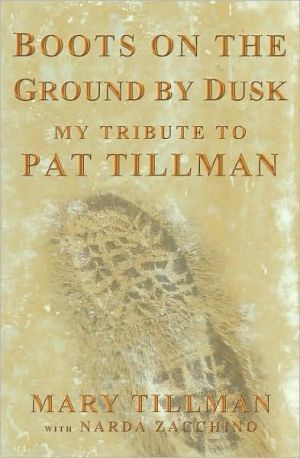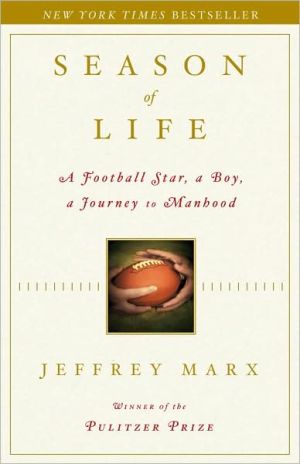Our Boys: A Perfect Season on the Plains with the Smith Center Redmen
An inspiring portrait of the extraordinary high-school football team whose quest for perfection sustains its hometown in the heartland\ The football team in Smith Center, Kansas, has won sixty-seven games in a row, the nation’s longest high-school winning streak. They have done so by embracing a philosophy of life taught by their legendary coach, Roger Barta: “Respect each other, then learn to love each other and together we are champions.”\ But as they embarked on a quest for a fifth...
Search in google:
An inspiring portrait of the extraordinary high-school football team whose quest for perfection sustains its hometown in the heartlandThe football team in Smith Center, Kansas, has won sixty-seven games in a row, the nation’s longest high-school winning streak. They have done so by embracing a philosophy of life taught by their legendary coach, Roger Barta: “Respect each other, then learn to love each other and together we are champions.”But as they embarked on a quest for a fifth consecutive title in the fall of 2008, they faced a potentially destabilizing transition: the greatest senior class in school history had graduated, and Barta was contemplating retirement after three decades on the sidelines. In Smith Center—population: 1,931—this changing of the guard was seismic. Hours removed from the nearest city, the town revolves around “our boys” in a way that goes to the heart of what America’s heartland is today.Joe Drape, a Kansas City native and an award-winning sportswriter for The New York Times, moved his family to Smith Center to discover what makes the team and the town an inspiration even to those who live hundreds of miles away. His stories of the coaches, players, and parents reveal a community fighting to hold on to a way of life that is rich in value, even as its economic fortunes decline.Drape’s moving portrait of Coach Barta and the impressive young men of Smith Center is sure to take its place among the more memorable American sports stories of recent years. Publishers Weekly Although Drape traveled to the Midwest to chronicle a record-setting high school football season, the tale he spins ends up being one that transcends athletics, a story of adolescence and smalltown life. Smith Center, Kans., is a sleepy locale 90 miles from the nearest McDonald's, a place with more windmills than people. But it's also home to Kansas's biggest football powerhouse, a team that entered the fall of 2008 with 56 straight victories and four consecutive championships. From the opening practice to the Redmen's final game, Drape flawlessly paints a picture of how Smith Center achieves perfection year after year. More importantly, he delves into the individual stories on the team: the tough but kindhearted coach who built a dynasty from nothing; the sure-fire college prospect; and the assistant coach's son, trying to live up to his father's legacy. All the while, Drape details the friendships he develops away from the field with the parents and other townspeople, and the mutual joy they bring the Redmen. With a clear sensitivity toward the difficulties facing the Smith Center players, along with more than a dash of humor, Drape gives the reader a team worth rooting for. (Aug.)
Our Boys\ A Perfect Season on the Plains with the Smith Center Redmen \ \ By Drape, Joe \ St. Martin's Griffin\ Copyright © 2010 Drape, Joe\ All right reserved.\ ISBN: 9780312662639 \ \ \ Chapter 1Championships aren’t won on the field; they are only played there.—Team motto for the summer, June 2008There was nothing but blue sky, miles and miles of it, disturbed only by cotton ball clouds that drifted across a horizon as flat as a tabletop and tiled with the gold, greens, and yellows of healthy crops. A John Deere combine, all shiny metal and sparkling glass, groaned in the distance as it knocked, skinned, and sorted wheat on the first day of what was going to be an abundant and profitable harvest. It had been a perfect summer, and farmers here were looking at an average yield of fifty bushels per acre at a price of anywhere from nine to eleven dollars. Those were big numbers, thanks to another year of healthy rainfall that had kept the farm ponds fi lled.Across thousands of acres of western Kansas, the combines would be working into the night as the farmers tuned in to the Kansas City Royals St. Louis Cardinals game on the radios in the cabs of the big machines. They would work around the clock over the next ten days, trying to bring in their harvest before a hailstorm or another calamity conjured by Mother Nature rendered all their hard work worthless. It was all hands on deck as eight- year- old grandsons and grown sons with desk jobs in Omaha or Topeka or Wichita came home and took turns driving the grain cart and bringing the crop in.Jay Overmiller, forty- seven years old, was inside his New Holland Combine, a $350,000 piece of machinery as vital to a farmer as an atom splitter is to a nuclear physicist. In many ways it was comparable: the computer screen told him the moisture of the grain— anything below 13 percent was good— and how many bushels of wheat he was getting per acre (fifty to seventy), as well as his fuel efficiency. Jay could even put the combine on automatic pi lot if he wanted, and close his eyes and listen to satellite radio. He also had about a half- million dollars’ worth of sprayers and tractors that he kept in immaculate condition. He had put a lot of money into these machines, but he still wasn’t sure whether he believed that farmers were about to become the new millionaires, as many fi nancial types predicted."I don’t know what my net worth is day- to- day,” he said. "I’m at the mercy of the guys who don’t have the wheat in their hands determining how much what I’ve got in my bins is worth.”He had been up at dawn for the twenty- minute drive to his parents’ house, where his mother, Jean, had breakfast ready for him, just as when Jay was a boy. His oldest son, Willie, was meeting him there after he finished lifting weights at Smith Center High School. Willie would be a sophomore when school began— and a fullback on the Redmen even sooner, when preseason camp started in mid- August."I’m one of those lucky guys who have coffee every morning with Mom and Dad,” Jay said.For the next fifteen hours, and over the next ten or so days of the wheat harvest, the Overmillers would choreograph an intricate ballet performed by giant farm machinery and aided by chutes and ladders as they farmed their three thousand acres. Jay bumped along in the combine until its lights started flashing, signaling to Willie that it was almost full of wheat. Willie then pulled alongside with the grain cart as Jay swung the chute overhead and let the wheat fall into the cart— neither one of them slowing down a bit. Willie took the load to Bill Overmiller— Jay’s dad, his grandfather— who waited on a gravel farm road with a truck. Another chute completed the transfer. Bill took the wheat to a bin, where a conveyor ladder sucked and dumped it once more.As soon as the wheat harvest was over, the countdown to Smith Center’s football season began in earnest. Jay had played for Coach Barta’s very first team in 1978 and had been one of the town’s early stars. He loved the game and was eager to watch Willie, as well as his younger boys, Trevor and Gavin, grow up under the coach’s tutelage.When Willie was in fourth grade, he asked Jay to build a regulation goalpost in the field in front of their home. Jay borrowed Coach Barta’s rulebook and constructed a goalpost to specifications. It rose in front of the family’s white barn with fifty yards of soft, manicured grass rolled out before it. The field had hosted pickup games ever since for Smith Center’s boys, from ages four to fi fteen. The goalpost looked as if it belonged here among the wheat and milo and soybeans every bit as much as the silver grain bins and turning windmills. Jay had taught Willie as much as he could; now it was the coach’s turn. He hoped Coach Barta would still be around when Trevor, thirteen, got to the high school, and yes, even eleven- year- old Gavin.At least he got Willie to him.I was eager for football season, too, and was in town to find a place to live as well as to reintroduce myself to as many Redmen as I could find. Like most small towns on the plains, Smith Center had struggled to retain its population. In 1900, more than 16,300 people inhabited Smith County, a number that had slowly dwindled as advanced farming techniques made human labor less necessary. As much of a marvel as it was to watch three generations of Overmillers bring in the wheat, precision farming also had run off too many folks who did not have the financial wherewithal to make the transition.It was the "dirty thirties,” as the old folks here still call it, however, that had sent people fleeing from Smith County in torrents. It was beyond dry, and dusty when tons upon tons of topsoil were blown off barren fields and carried in storm clouds for hundreds of miles. Southeastern Colorado, southwest Kansas, and the panhandles of Oklahoma and Texas became the epicenter of dust storms. In 1932, fourteen of them were recorded on the plains. In 1933, there were thirty-eight. By 1934, it was estimated that 100 million acres of farmland had lost all or most of the topsoil to the winds. In the early spring of 1935, there had been weeks of dust storms, but the cloud that appeared on the horizon on Sunday, April 14, 1935, was the worst. Winds were clocked at sixty miles per hour, and "Black Sunday” introduced a new term to our national lexicon: the Dust Bowl.On the same day that dust was swirling along America’s Great Plains, Hugh Hammond Bennett, an adviser to President Franklin Delano Roo se velt, was preparing to testify before Congress about the need for soil conservation legislation. Mother Nature seconded his argument when a dust storm rolled from the heart of America into the nation’s capital."This, gentlemen, is what I have been talking about,” Bennett would tell Congress.It was a theatrical fl ourish, and Congress, indeed, passed the Soil Conservation Act. But it was too late to reverse the damage inflicted on places like Smith County. By 1940, the county had lost more than a third of its population, as only 10,582 remained. It has been hemorrhaging population ever since; today about 4,500 people live in the county, and over the years clothing and sporting goods stores, dry cleaners, and all major manufacturing have disappeared. Smith County’s annual per capita income is only $14,983, which makes it the fi fth poorest of the state’s 105 counties.Good economic news is still hard to come by. More than fifty people had recently been laid off at Peterson Industries, which manufactures trailers and campers and is Smith County’s second- largest employer behind the school district. Thirty- six miles west of here in Phillipsburg, the Brooke Corporation, an insurance and fi nancial ser vices company founded by a Smith Center banker, was on the verge of bankruptcy and about to put two hundred people out of work, many of them from Smith County.Even the Transcendental Meditation movement appeared to be giving up on its plan to bring anywhere from ten thousand to forty thousand students to the Maharishi Central University that had been under construction on three hundred acres ten miles north of town. No one was particularly thrilled when the group announced in 2006 its plan to build a series of peace palaces and an organic farm. Over the past two years, however, the group’s leaders had been a presence in town, and construction crews worked on more than a half- dozen buildings.No more. It had been months since anyone had seen the "TMers,” as they were known, and the metal frames of their buildings dotted the countryside like the carcasses of picked-over scarecrows. In fact, no one had left much behind in Smith County. There were hollowed- out farm houses overgrown with Indian grass that were home to pheasants and quail and the occasional methamphetamine laboratory.This was my third visit since the previous November, and I had yet to secure a place to live. It was an inventory problem; rentals were non ex is tent, and I counted just nine homes for sale. I had been able to look at only one dwelling, a duplex that even by Manhattan standards was far too small. Bob Rethorst, one of the two real estate agents in town, counseled patience and assured me that something would turn up. He was eighty- two years old, a six- foot, four- inch hulk of a man with snow- white hair who inspired confi dence. So I did as I was told and didn’t worry.While the Kansas plains at dusk during harvest offer about as majestic a tableau as you can conjure, the town of Smith Center does not turn any heads at first blush. Highway 36, which spans the county east west, is the town’s northern border. The speed limit drops from sixty- fi ve to forty- five miles per hour at the first sight of the John Deere tractors that stand sentry and ready for sale at Jones Machinery to the east of town, and at Landmark Implements to its west.In between them are the Buckshot Inn and two other motels, the Prairie Winds and U.S. Center. There is a boarded- up bowling alley and a jumble of tin and wood buildings with ramshackle signs advertising body and auto repair shops. The Jiffy Burger is south of Highway 36 and fronts Smith Center High School, and the Pizza Hut and Paul’s Café and Dining Room are on the highway’s north side.There is a blinking yellow light at the intersection of Highway 281, which runs north south from Nebraska to Oklahoma, and which for ten blocks is Smith Center’s Main Street. Clapboard ranch houses with stone basements lead into the business district and past brick buildings to the railroad tracks and the grain elevator. Here, the Smith Center Co- op Elevator sprouts drums and an eight- pack of white turrets from a gravel parking lot and is the first thing anyone sees from far away on the highway. It looks like a medieval castle.As you get closer, however, another image takes pre cedence: rising from wheat fields and surrounded by farm machinery are the lights of a football stadium, the Hubbard football complex. It has helped Smith County endure decades of people and businesses leaving, as well as years of drought that tested the hardiest of farmers. It is the home of the Redmen, who for a long time now have delivered what TM’s Eastern thinkers had promised but apparently abandoned: peace and harmony.The Redmen’s football complex sits on a street called Roger Barta Way. In the wake of the Redmen’s winning streak and the national attention it commanded, the Smith Center City Council decided to name the road to the high school after its football coach and retired math teacher. Coach Barta usually caught wind of such machinations, but he was genuinely surprised when the decision was announced at a high school basketball game the previous winter. He was honored, but not altogether comfortable with it. He was conscious of the fact that athletics most often trumped academics in communities, large and small, and he did not want to add to that perception. He hoped that a street near the school might be named for his friend and colleague Demetre Evangelidis when the latter retired. "Mr. E,” as the students called him, had taught chemistry for twenty- five years at Smith Center High School and was considered one of the most committed and effective teachers in the region.Even in the summer, Smith Center knew where its young people were— at the high school. They were there this evening on the last day of June, a hundred of them, boys and girls from the seventh to twelfth grades, lifting barbells in the weight room and running sprints out on the back lawn. Kids swarmed the parking lot on the south and east sides of the high school, looking for some relief from the suffocating ninety- two- degree heat.Among them was Marshall McCall. He was hoarse and sniffled and tried to clean up after a nose that was leaking at a far greater rate than his sweat. He was a smart, well- mannered seventeen- year- old and wiped his nose with his T-shirt discreetly when he hoped no one was looking. Marshall was supposed to be at wrestling camp at the University of Nebraska, but he had been battling a virus savage enough to strip ten pounds off his fi ve- foot, ten- inch frame over the past three days. Marshall had prolonged his illness by working through the virus, showing up each morning for his summer job as a plumbers’ assistant and trench- and- grave digger. Now he was pale, raccoon- eyed, and looked nothing like the square- shouldered All- American Opie that he was a few days ago.Marshall should have been home in bed. Instead, he headed for the practice field just outside the weight room for agility drills with a dozen of his football teammates in tow. Marshall was a se nior and one of four captains elected by his peers at the beginning of the summer to lead the Red-men to what was destined to be a record- breaking year. No, it had the potential to be an immortal year.Marshall was hoping to get a scholarship to play football in college, but it was not something he could count on. Healthy and in shape, he was barely 165 pounds, and on his best day he ran the forty- yard dash in 4.7 seconds, which is neither big nor fast enough to entice big- time Division I football coaches to Smith Center. He knew it, and so did his parents. They had decided that Marshall should apply early to the state schools— the University of Kansas, Kansas State, and Fort Hays State— so he could concentrate on his se nior year, and perhaps his last season of football, and they could be assured their son had somewhere to go to college.Marshall worked from 7:30 a.m. to 6:00 p.m., saved his money, and prayed at night that he might get a partial scholarship to a smaller school like Sterling College, which was two hours due south, or perhaps Washburn University in Topeka, where his dad had played football.Marshall knew that saving for college meant digging the hole where the father of his ju nior high school football coach, Darren Sasse, was going to be laid to rest, putting on a coat and tie for the funeral, and then shedding both to shovel dirt on the casket after the ser vice. He had done just that recently, and it was OK with him. It beat the hell out of getting itchy baling hay, as he had done six previous summers, in the scorching heat that turned the plains of Kansas into a micro wave where the only relief was an overheated breeze that felt like it packed darts.Marshall’s boss, Tracy Kingsbury, had told him that grave digging was upholding a sacred trust in a town that was held together by a love for these flatlands, an abiding respect for its heritage, and empathy for the struggles its families had shared over generations.Really, Kingsbury told him, it was "the ultimate job security.”The ubiquitous death notices in the Smith County Pioneer proved Kingsbury right. For the last fifteen years there has been a run on death here. The Hill, as the cemetery north of town is known, was becoming one of Smith County’s few overcrowded neighborhoods, increasing its occupancy at the rate of 125 new residents a year, and prompting the old folks of Smith Center to hold their young people close as long as possible.At the high school this eve ning, the weight room was full, and iron dumbbells clanged to the beat of loud heavy- metal music. Next door in the gym, applause echoed and a referee’s whistle pierced the air, giving rhythm to a summer volleyball tournament.Outside on the practice field, Marshall lined up orange cones while Doug Boucher, a strength coach, dragged out a rectangular rack divided in squares for the boys to high- step through. Suddenly, a squeal of tires and the crunch of fl ying gravel interrupted the quiet. A yellow Sierra Spider spotted with rust fi shtailed near the practice fi eld."Slow down, son,” bellowed Boucher.Marshall and his teammates snapped their heads to the parking lot, where Dillon Corbett— all six feet, two inches of him— unfolded himself from the little car. He smiled a goofy grin and took a seat on the grass to lace up his football cleats.Boucher shook his head, bewildered."Son, do you want kill somebody?” he asked. He did not wait for an answer. "Have some sense, boy.” \ Excerpted from Our Boys by Joe Drape.\ Copyright © 2009 by Joe Drape.\ Published in August 2009 by Times Books.\ All rights reserved. This work is protected under copyright laws and reproduction is strictly prohibited. Permission to reproduce the material in any manner or medium must be secured from the Publisher. \ \ Continues... \ \ \ \ Excerpted from Our Boys by Drape, Joe Copyright © 2010 by Drape, Joe. Excerpted by permission.\ All rights reserved. No part of this excerpt may be reproduced or reprinted without permission in writing from the publisher.\ Excerpts are provided by Dial-A-Book Inc. solely for the personal use of visitors to this web site. \ \
\ Publishers WeeklyAlthough Drape traveled to the Midwest to chronicle a record-setting high school football season, the tale he spins ends up being one that transcends athletics, a story of adolescence and smalltown life. Smith Center, Kans., is a sleepy locale 90 miles from the nearest McDonald's, a place with more windmills than people. But it's also home to Kansas's biggest football powerhouse, a team that entered the fall of 2008 with 56 straight victories and four consecutive championships. From the opening practice to the Redmen's final game, Drape flawlessly paints a picture of how Smith Center achieves perfection year after year. More importantly, he delves into the individual stories on the team: the tough but kindhearted coach who built a dynasty from nothing; the sure-fire college prospect; and the assistant coach's son, trying to live up to his father's legacy. All the while, Drape details the friendships he develops away from the field with the parents and other townspeople, and the mutual joy they bring the Redmen. With a clear sensitivity toward the difficulties facing the Smith Center players, along with more than a dash of humor, Drape gives the reader a team worth rooting for. (Aug.)\ \ \ \ \ Kirkus ReviewsTurning his attention from horseracing (To the Swift: Classic Triple Crown Horses and Their Race for Glory, 2008, etc.), New York Times reporter Drape follows a high-school football dynasty. In November 2007, the author's front-page Times article about the Redmen-a team from Smith Center, Kan., that had clinched four straight state championships-garnered so much interest that he decided to uproot his family from New York and return to Smith Center the following year to see if the Redmen could make it five in a row. Drape's season-long enchantment with this quaint town (pop. 1,931) at the geographical center of the continental United States colors his account as much as his detailed coverage of the Redmen's incredible 2008 season, during which, despite having lost 12 seniors, the team averaged 50 points per game while holding opponents to a meager nine. Though much of Drape's analysis of the Redmen's uncanny success rests on the it-takes-a-village mentality shared by members of the close-knit Smith Center community, at the heart of this tale of fortitude is the strategic and motivational genius of Roger Barta, who, during 31 years as the head coach, has won 289 games and eight state championships. His simple mantra-"Life is not about winning or losing; it's about competing. It's about working hard and getting a little bit better each day"-instilled in his young players and devoted staff the work ethic required to sustain their remarkable success. Though a bit overlong-the story would probably work better as a long-format magazine piece-the book will certainly appeal to fans of Friday Night Lights and other accounts of small-town sports glory. A feel-good story of youthful drive, greatcoaching and the value of unflagging communal support. Agent: Robbie Anne Hare/Goldfarb & Associates\ \ \ From the Publisher"Our Boys is about far more than football. It’s an inspiring story about how a coach and a community are building young men with the simple values of love, patience, and hard work. This is a great book."—Joe Paterno, head football coach, Pennsylvania State University\ "If you want to turn away from the high-voltage auctioneer babble that surrounds big-time, big-money sport, take this trip to Smith Center, Kansas, with Joe Drape. This is organic stuff, a fat and healthy slice of unadulterated American life. Simply terrific."—Leigh Montville, author of The Big Bam and At the Altar of Speed\ "Our Boys delves into the heart of America in a manner that reminds me of The Last Picture Show and Friday Night Lights. Joe Drape crafts a terrific tale that will make you laugh, cry, and think. This is a story about small-town America that will make you shout."—Jim Dent, author of Twelve Mighty Orphans and The Junction Boys\ "Joe Drape tells the remarkable story of the Smith Center Redmen, not only their success in winning football games, but also in swelling pride for a community and building character in young men. He shows that Roger Barta and the people in Smith Center are winners in every sense of the word."—Bob Stoops, head coach, University of Oklahoma\ "Joe Drape has caught something deep and beautiful in Our Boys. It is true to the reality of life on the plains, much more than another football story."—David Maraniss, author of When Pride Still Mattered: A Life of Vince Lombardi\ "A great read for all, but even more so for big-city readers to get a taste of the quality of life and genuine caring of this small community and its revered teacher, mentor, and coach – Roger Barta. It is not so much a story about football but about the true meaning of midwestern values, family life, and the spirit of small town Kansas and its special people. I couldn’t put it down."—Bill Snyder, head coach, Kansas State University\ "A feel-good story of youthful drive, great coaching and the value of unflagging communal support."—Kirkus Reviews\ "The tale [Drape] spins ends up being one that transcends athletics, a story of adolescence and smalltown life. . . . From the opening practice to the Redmen’s final game, Drape flawlessly paints a picture of how Smith Center achieves perfection year after year. . . . Drape gives the reader a team worth rooting for."—Publishers Weekly\ “‘Hoosiers’ on a football field.”—New York Post\ “The most improbable, unabashed love story I've read in years.”—Minneapolis Star Tribune\ “A compelling story expertly told.”—Pat Forde, ESPN.com\ \ \
